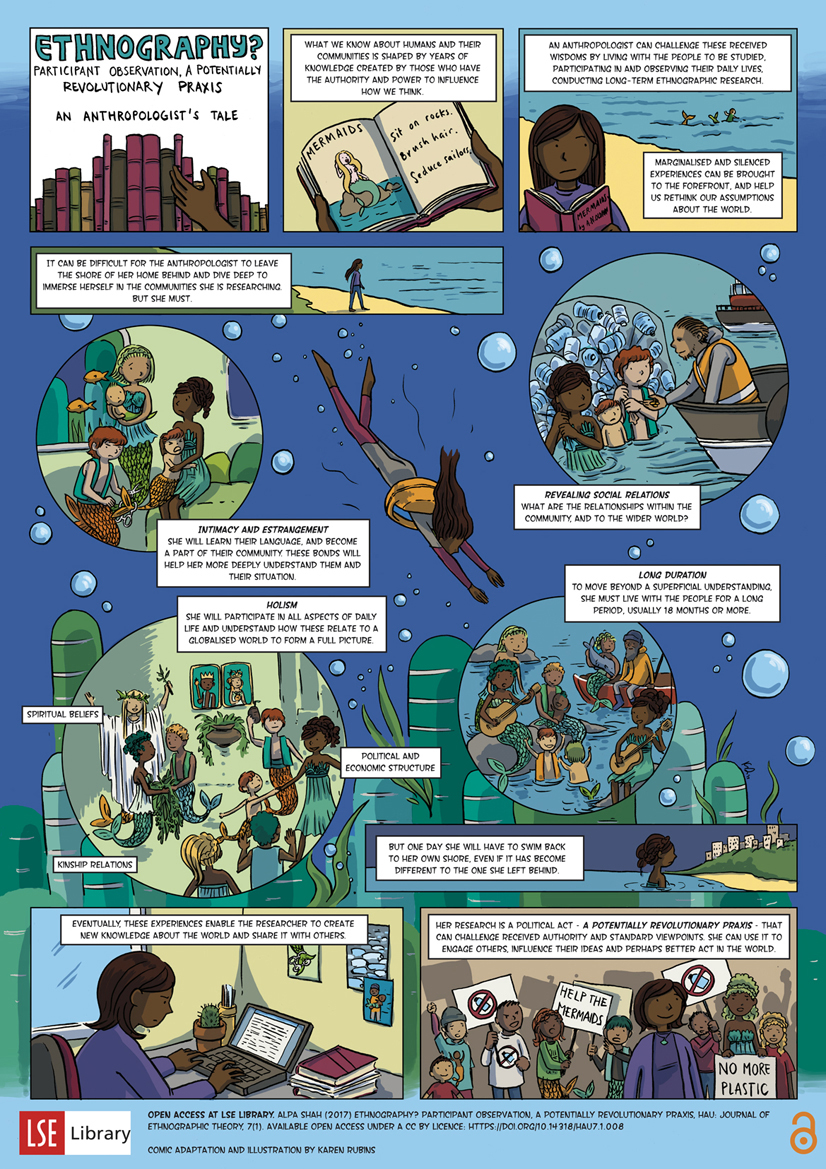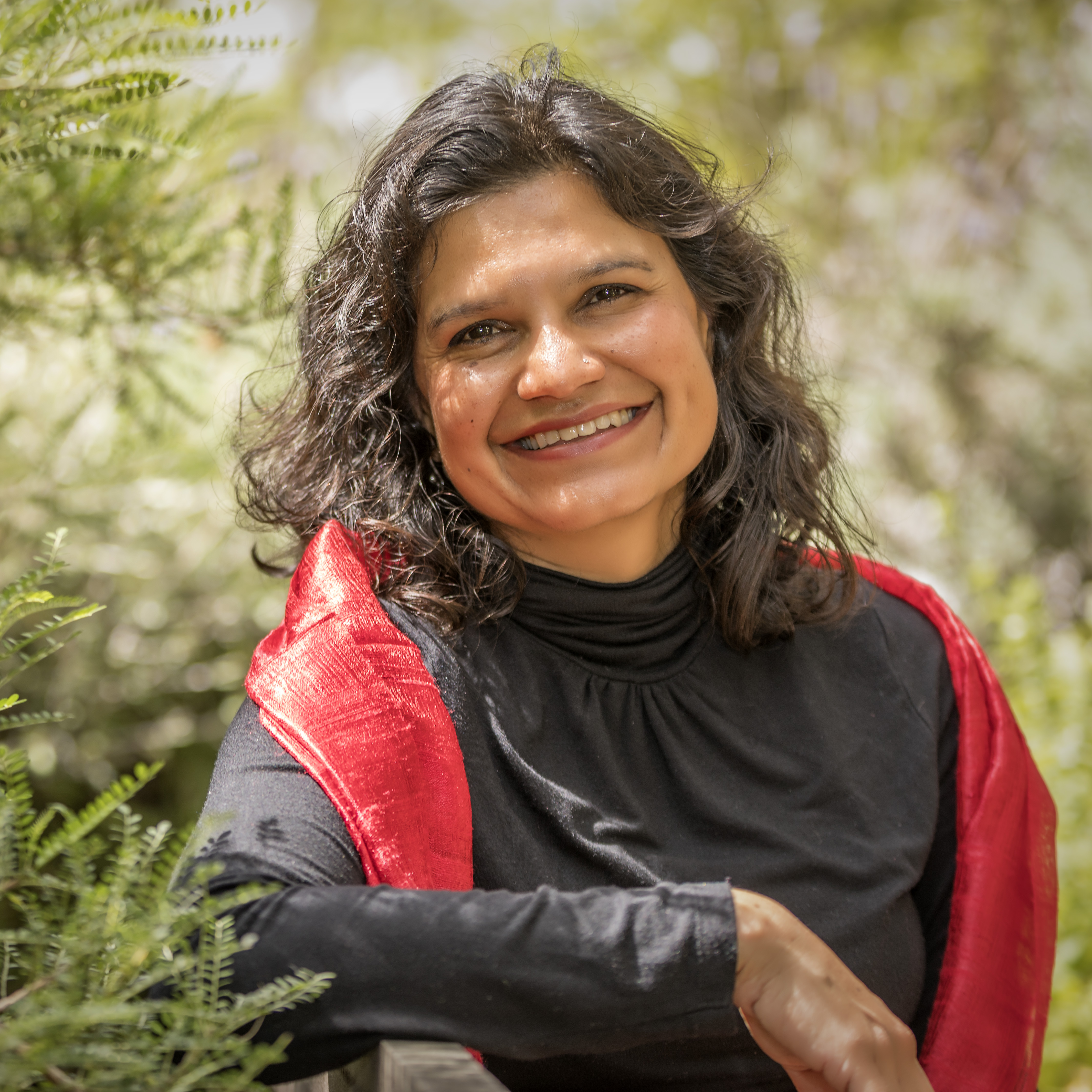If you read some of our ‘About Social Anthropology’ and ‘Thinking like a Social Anthropologist’ resources, you’ll see that the field emphasises lenses for viewing the world, rather than a particular or narrow subject matter. But still, we are an empirical field that does research and gathers and analyses data! So, how do anthropologists do this?
This 8 min video profiles the fieldwork of three professional anthropologists at MIT in the United States, outlining their specific interest areas and how they ‘do’ anthropology – from Associate Professor Erica Caple James’ fieldwork with Haitian migrants and refugees at a Social Service Center in Dorchester, Massachusetts, to Professor Stefan Helmreich going under the ocean alongside marine biologists, and Professor Heather Paxson’s studying the culture and economy of artisan cheese making in Vermont! While they spend time in vastly different ‘fields’, they use similar methods and tools, some of which we explore below.
Ethnography
Ethnographic research is a qualitative method for studying human cultures and communities through case studies. It is based on detailed observations of people, in their real, everyday contexts. Anthropologists pioneered this method, and still rely heavily on it, but lots of other disciplines use it now, too.
Ethnography has typically emphasised long-term, and in-depth research. Historically, when anthropologists did ethnography, they went to live among a culture that was not their own. The place, community, or group they researched with was referred to as ‘the field’. So they went to the field, and did ethnographic ‘fieldwork’. Some tips for rich fieldwork is shared in this video.
Today, however, plenty of people research in their own cultures and communities (e.g. ‘anthropology at home’), online, or across multiple sites. Thus ‘the field’ can be fuzzier to define than it first appears. See also our ‘positionality’ section below.
Although it doesn’t require special or expensive equipment, it does take time (as this blog post discusses in relation to market research), so it isn’t always perceived as ‘efficient’. This blog post highlights 7 characteristics of ethnographic research in a handy infographic (related to corporate research). Because ethnography requires a lot of time investment, some researchers may instead “borrow ethnographic techniques” (Wolcott 2008), by which we mean they might adopt some of the strategies or values or ethnography, and adapt them to suit different projects.
Some common values of ‘ethnographic’ research remain, such as having a holistic and contextualised view of a particular place, event, social group or cultural practice. A core goal is still to gain (and communicate) first-person, or emic understandings of lived experience, and a lot of this relies on a sense of ‘being there’. Social anthropology rarely tries to place the researcher as a distanced observer, but instead values the idea of the researcher becoming an active ‘participant-observer’ (though of course this can get messy, and requires lots of reflexivity and attention to ethics).
Participant-observation
This wonderful graphic comic uses mermaid’s as an analogy, to show how participant-observation forms a central part of the process of ethnography.
The comic is based on an article by a real anthropologist, Alpa Shah (based at the London School of Economics), who went to study a revolutionary guerrilla army, in India. The people she lived with were often painted as terrorists by the government and the media, but by spending time with them, she was able to understand more about the context of their lives, and their values, and to write about this.
There is another great real-world example in this 3min video, focussing on a postgraduate student who spent 18 months participating in the Last Vegas ‘street car’ scene, as her ethnographic research.
A further example is this 7min TED talk given by an anthropologist who studied garbage in New York City, using the technique of participant-observation – a research methodology that clearly applies to many diverse settings.
Fieldnotes and Thick Description
When doing ethnographic fieldwork, social anthropologists often collect data in the form of descriptive fieldnotes. This term usually refers to written notes, sketches or diagrams, although social anthropologists commonly take photos and/or videos, and record interviews too. This short video includes a professor talking a bit about what fieldnotes are, and what they are for, and this one is a vibrant piece from a PhD student doing fieldwork in Thailand, that talks about the many forms fieldnotes can take and some examples of his own.
There is a specific mode of descriptive writing associated with ethnography, called ‘thick description’. Thick description means putting your observations in context and writing about their meaning, not just writing down the literal facts. The famous example is a wink – not just ‘an asymmetrical contraction of facial muscles’ (thin description), but something conspiratorial, flirtatious, humorous, or sassy, depending on the people, spatial settings, time of day, and other actions before and after (thick description). More on Clifford Geertz, who used this example and introduced the phrase ‘thick description’, can be found here.
Interviews
Interviews are a really useful tool for social anthropologists. Informal conversations with people are a common part of participant-observation, in most settings; however, having a slightly more formal, recorded interview can extend or supplement these. Or sometimes, depending on practical or ethical constraints, there is no chance to do participant observations, and interviews can stand alone as a rich way to analyse culture and social life, through hearing people’s stories, studying language, narrative, emotion, and more.
Digital, visual, and media techniques
This page shares the work of the ‘Sensory Ethnography’ lab, that deals with cutting edge digital techniques. And here you will find a ‘learning pack’ (for both teachers and students) focused on the variety of ways illustration can be used by anthropologists. If you check out our ‘communicating like an anthropologist’ page you’ll see more ways that these types of data-gathering can also translate into unique outputs (like film, or dance).
Reading
 A large part of a social anthropologist’s work is reading what others have already written on our subjects of interest. It is important for understanding context, gathering multiple perspectives, and understanding theoretical (etic) lenses that have been applied previously. The type of reading anthropologists engage in when conducting ethnographic research can cross a number of genres, from ethnographies and other academic texts (e.g. peer-reviewed journals and published books by academics), to archival/historical documents (first hand accounts, old newspapers etc), to current media coverage and social media. These are sometimes split into ‘primary’ and ‘secondary’ texts, which are treated differently – with ‘secondary’ texts being those produced by scholarly processes, and ‘primary’ texts produced within the social world/s we are studying, and viewed more as ‘cultural artefacts’.
A large part of a social anthropologist’s work is reading what others have already written on our subjects of interest. It is important for understanding context, gathering multiple perspectives, and understanding theoretical (etic) lenses that have been applied previously. The type of reading anthropologists engage in when conducting ethnographic research can cross a number of genres, from ethnographies and other academic texts (e.g. peer-reviewed journals and published books by academics), to archival/historical documents (first hand accounts, old newspapers etc), to current media coverage and social media. These are sometimes split into ‘primary’ and ‘secondary’ texts, which are treated differently – with ‘secondary’ texts being those produced by scholarly processes, and ‘primary’ texts produced within the social world/s we are studying, and viewed more as ‘cultural artefacts’.
Undergraduate university courses usually have a ‘required readings’ list for each paper. At first, social anthropology readings can appear quite overwhelming, especially when you’re transitioning from the sciences! Students often comment on how long the readings are, about all the jargon, about not knowing what to focus on, how they are relevant to lectures, or how to incorporate them into a research essay. Below we provide some tips.
“...do your readings! The course is really not the same without them.”
“DO! YOUR! READINGS!!!! Only this year have I gotten into a good habit of doing all (or most) of my readings and I feel like my development and understanding in this field has increased tremendously.”
- Consider the authors' positionality. Who wrote the text? Do they talk about themselves, or what their potential biases might be? Who is the publisher? Is the author connected to/funded by a specific institution (e.g. University? News agency?)
- Is there a balance between an etic and emic perspective, or does it lean one way over the other?
- Ask whose voices are represented and whose are missing. What sources of information does the author use? Are they relying on one source too much?
Comparison
In social anthropology we learn from difference, and we learn through difference. The practice of cross-cultural comparison (comparison between cultures) has been a part of the field since it’s beginnings. We can learn from observing the many different ways that people deal with similar things; from different ways of eating, to different ways of dancing, to different ways of forming families, or different structures of leadership… and the list goes on.
Some anthropologists choose to study more than one place, group, or culture as part of a particular project, to emphasise this (called multi-sited ethnography). More often they have one group, place, or culture that they focus on, studying deeply and holistically, and then they draw on other people’s published work about different groups or cultures, in order to make comparisons. This comparative technique helps us learn about both diversity and sameness, nature and nurture, among human beings.
We do have to take care when we compare though…
Ethics
Most academic institutions have ethics procedures, committees, and forms, to guide research; using values like ‘informed consent’ as important baselines. Social anthropologists engage with all of these, of course. But we also have our own perspective on ethics that relates to the type of work we do.
There are 2x lectures online here (Ethics – Lecture 1, 12mins & Ethics – Lecture 2, 10mins), which focus on ethics in cultural anthropology. The first addresses power, knowledge, and harm. The second gives a famous example of ethnographic research that was deemed unethical, and was also misused in a number of ways.
In practice, a lot of the ethics in our field, because of our methods, is a ‘relational ethics’ that involves keeping participants in the loop, getting their feedback on how we portray them, and thinking about the impact of our representations. Speaking from her first hand experience, Professor Sienne Craig shares what this kind of ethical thinking can look like in social/cultural anthropology in this 3 min video. Relational ethics is often also related to critical thinking, decolonisation, and reflexivity (see our ‘Thinking like a social anthropologist‘ section).
Positionality (as a part of reflexivity)
Producing knowledge as a researcher is not a neutral activity, and the researcher themselves are not a neutral presence. We need to ask questions about the social position (i.e. gender, ethnicity, age, class, religion, and so on), and what forms of social power or privilege they have, relative to participants.
This is because the researcher’s positionality will shape not only the practical access they have to ‘the field’, but also the way they perceive, analyse, and produce knowledge about that field. The parable of the elephant and the blind men, told beautifully in this video is a great way to understand this. If you haven’t already, check out our reflexivity section for a bit more context.
In social anthropology we believe that being totally objective isn’t really possible, since we are all cultural, subjective beings. So rather than aim for that, we aim for transparency and reflexivity instead – as discussed in this 6min video (which isn’t of great visual quality, but has great content). One of our own undergrad students, who came into social anthropology from a science background, explained it this way:
“Coming from the natural sciences, having the objectivity of the scientific method – and science in general – questioned, can be very confronting. But social science’s critique of science (and objectivity) does not remove the value of other frameworks, it adds to them and elaborates upon them in a way which is academically sound and ultimately, deeply satisfying – as well as very important in today’s drive towards multidisciplinarity.”
As discussed also in our Communicating like a Social Anthropologist section, it is often important to communicate about our positionality, to participants and readers of your work, so they can understand (and work out for themselves) where you are coming to the study from, as a person as well as an academic.
Insider/Outsider Status
One aspect of the researcher’s positionality we need to consider, especially with the goal of being a participant-observer, is whether they are an outsider or an insider to the group they are trying to understand? Or more commonly, a bit of both? It will depend totally on the study and on the researcher, and may change over the course of the research, but basically, it’s hardly ever clean-cut. In fact, anthropologists are known for walking the line between ‘insider’, and ‘outsider’ – and it turns out this in-between space can be a really rich and useful (if sometimes uncomfortable) place from which to gain insights. This links back to the emic and etic lenses discussed here, which can be toggled back and forth between. But as ever, it requires lots of reflexivity to ask questions about how our relationship to those we study may limit, benefit, and generally shape our data.





